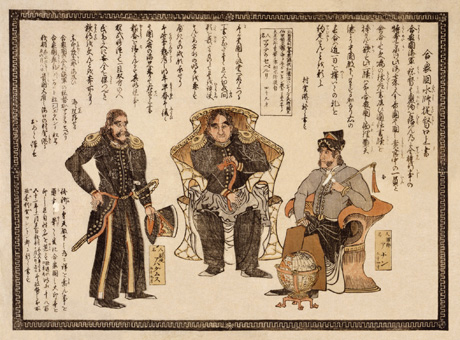Navigation auf uzh.ch
Navigation auf uzh.ch
As a visiting scholar at the URPP Asia and Europe, Professor David L. Howell shared his profound knowledge of Early Modern Japan with junior researchers and professors participating in the institution. In his seminar and public lecture he questioned the usual narrative of the inevitable opening of
Japan to the West in the middle of the nineteenth century and emphasized the importance of considering it as part of the Pacific World.
David L. Howell

In the seminar a lively group of students and I discussed a series of works, mostly in English, on the history of Japan during the Meiji period (1868–1912). The reading list was quite eclectic, with topics ranging from philosophical musings on how to consider the trope of ‘nature’ in political discourse to empirical studies of foreign policy and public health regulations. I was impressed at how well the students assimilated the works, all the more so when one considers that few of them had much background in the study of Meiji history per se.
How was the history we discussed ‘contested’—or, given that all history is contested, what was peculiar to Japan about its contestation? The key point came down to a question of how Meiji Japan, as a self-consciously ‘modernizing’ regime, would situate itself vis-à-vis the Western powers that served as its model of modernity. Decades ago, a seminar like this would have taken Western modernity as a given, its characteristics fully formed and in place by around the middle of the nineteenth century. Significantly, the West that that decades-ago seminar would have considered in counterpoint to Japan would have comprised big, militarily powerful nations like Britain, France, the United States, and perhaps Prussia/Germany—but not the many smaller European countries, including Switzerland.
In contrast, the readings we looked at for the most part avoided taking the West and its modernity for granted. Instead, they treated modernity itself as a kind of moving target, nearly as new in the West as in Japan and certainly always evolving. Moreover, in contrast to earlier historiography, they were keenly aware of Japan’s place in East Asia. That is, rather than looking at Japan’s encounter with Western-style modernity in terms of a binary relationship between Japan and Europe (and the United States), they endeavored to situate Japan within East Asia as well as within a rapidly changing world.
With this perspective in mind, we examined questions such as the nature of the public sphere in the waning years of the Tokugawa period (1603–1868) and how it connected to the emergence of a sense of public opinion during the first decade or so of the Meiji era. This approach helped us to avoid privileging too much the transformative impact of Western-style technologies and media—the modern newspaper in this case—while giving due credit to the importance of institutions, including the political ones that allowed—and prohibited—different types of public discourse. The same sensibility helped us to make sense of broad issues, such as problems of historical periodization and the nature of international law, as well as very narrow ones, such as whether modernization demanded burial or cremation to deal with the remains of the dead and the relationship between women’s hairstyles and the Japanese embrace of modernity.
I found the seminar to be very lively and the students to be quite engaged with the material. Their varied disciplinary backgrounds—ranging from art history to law to public health and so on, in addition to Japanology—added numerous valuable perspectives to our sessions.
For my public lecture, I spoke on the topic of “Foreign Encounters and Informal Diplomacy in Early Modern Japan.” An essay of the same title will appear in the Journal of Japanese Studies in the summer of 2014. In the talk (and essay from which it was drawn), I described two incidents that occurred in the summer of 1824, in which crewmen from English whaling ships landed without permission at Ōtsu, a village in the Mito domain northeast of Edo (modern-day Tokyo), and on Takarajima, a small island to the far southwest of Kyushu.
In the talk I stressed three broad themes. One was to situate the incidents within a narrative of late Tokugawa foreign policy. This is the way in which they have been studied by previous historians. The neo-Confucian scholar and ideologue Aizawa Seishisai 会沢 正志斎 (1781–1863) interviewed the men who landed in Mito and concluded that they represented the vanguard of British imperial aggression toward Japan. He was correct in the sense that whalers’ activities heightened British (and later, American) interest in the country, but the connection was indirect insofar as the whalers operated independently of British government control. In any event, as a result of the landings, the Tokugawa shogunate ordered coastal batteries to fire on virtually any Western ship attempting to approach the shore, a policy that remained in effect (though rarely actually implemented) from 1825 to 1842.
The other two themes of my talk represented a departure from the existing literature. One was to invoke the notion of “informal diplomacy,” by which I mean unofficial, unscripted interactions between common people and foreign visitors. Because the Tokugawa shogunate prohibited Japanese from traveling abroad and likewise severely constrained the movements of the few foreigners who were allowed into the country, the vast majority of Japanese people never encountered anyone from another country before Commodore Matthew Perry’s so-called opening of Japan in 1854. The other novel theme was to invoke recent works by historians such as Matt Matsuda, David Armitage, and David Igler on the Pacific Ocean—particularly the idea of a multiplicity of Pacific Worlds—and to place the Japanese encounters within that framework. My goal was to suggest a way that we might free ourselves from the teleology of Japan’s opening, which is almost always presented as a series of increasingly insistent overtures from Russia, Britain, and the United States leading to the inevitable denouement represented by Perry’s gunboat diplomacy.

Although one might expect people who had no previous experience with outsiders to react with alarm or at least great surprise when the twelve whalers landed at Ōtsu village, they in fact evinced no fear at all. The reason for this, it turns out, is that fishers from Ōtsu and other villages on the Mito coast had been trading surreptitiously with English whalers for two or three summers, exchanging things like Japanese paper and hanten 袢纏 coats for bits of cloth, articles of clothing, razors, knives, coins, and buttons. Although the evidence is not entirely clear, it seems likely that the landing party chose deliberately to go to Ōtsu, where they apparently already knew a fisher, Yūsaburō, who served as interpreter (using mostly sign language) during their sojourn. In any event, in distinction to the xenophobia of officials like Aizawa Seishisai, the commoners of Mito built on their previous experience with whalers to develop a pragmatic view of the men and their purposes in coming to Japan. In contrast to the relatively relaxed intercourse in Mito, the whalers who approached Takarajima did so without any previous history of contact between islanders and foreigners—Takarajima lay far from the usual whaling grounds—and as a result, fear and suspicion quickly led to bloody violence.
My attempt to situate early modern Japan within a Pacific World is admittedly tentative. At its center is the idea that placing Japan within the Pacific helps us look beyond our customary narratives of seeing Japan’s place in the world in terms of state-to-state relations. Instead, we see Japan from the whalers’ perspective, as one of a myriad islands and coasts that they approached as the need arose to obtain fresh food and water and offer relief to crewmen who suffered from scurvy and other ailments, which they thought were exacerbated by the physical fact of being at sea. Whalers exchanged information about the peoples they encountered, marking some as hospitable and eager to trade, and others as suspicious and violent.
For a brief moment in the 1820s, the Pacific coast of Japan became part of the whalers’ Pacific World, a site beyond nations, in which all diplomacy was informal. Soon enough, the Tokugawa shogunate stepped in to remove Japan from that Pacific World. The whalers’ activities became the concern of the state and all further negotiations over their presence in Japanese waters were delegated to agents of the state, including the British and American governments as well as the shogunate.
In both the seminar and in my public presentation, I sought to suggest ways in which we might transcend the teleology of Japan’s opening in the middle of the nineteenth century and its later emulation of Western-style modernity in the decades thereafter. My goal was not so much to upend existing narratives but to complicate them in ways that might open vistas to new research in the future.
David L. Howell is Professor of Japanese History at Harvard University. He received his B.A. from the University of Hawai’i at Hilo and Ph.D. in History from Princeton University. He taught at the University of Texas at Austin and at Princeton before joining the Harvard faculty in 2010. Howell is the author of Capitalism from Within: Economy, Society, and the State in a Japanese Fishery (1995) and Geographies of Identity in Nineteenth-Century Japan (2005) as well as numerous articles.
Howell’s research focuses on the social history of Japan in the Tokugawa (1603–1868) and Meiji (1868–1912) periods. In December 2013 he was a visiting scholar at the URPP Asia and Europe.
(Asia & Europe Bulletin, 3/2014, pp. 4–6)